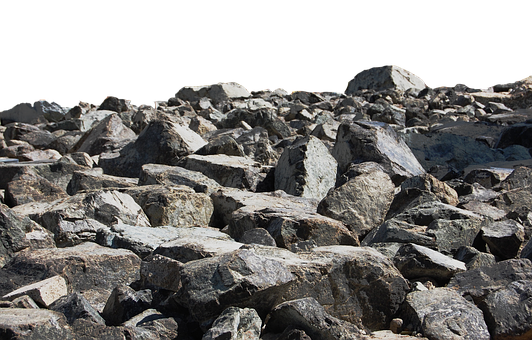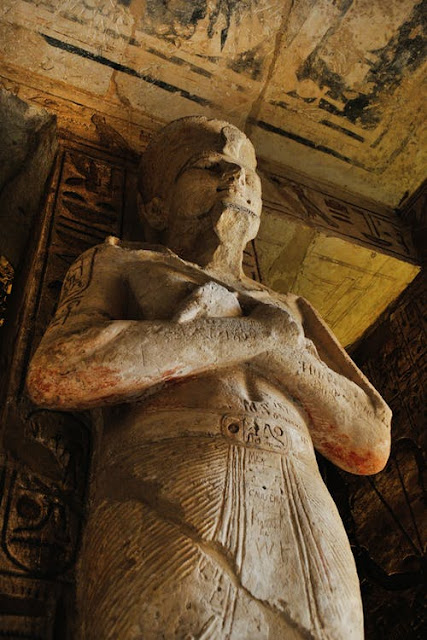The Egyptian pyramids are one of the
most mysterious miracles in the world. After centuries of research, scientists
are still unable to determine how they were made. Although archaeological scientists have succeeded in
finding these huge burial sites of some of the details, but will find a new
puzzle every day.
Many scientists believe that the largest pyramid was built
by 20,000 people in 20 years
For centuries, the Great Pyramid was believed to have been
built by Pharaoh Khufu around 2550 BC and is the largest building in the
world. Historical discoveries tell us that the Egyptians used only wooden
tools, ropes and pulleys, and 20,000 workers built the Great Pyramid within 20
years.
The pyramid was built without the help of wheels
Scientists believe that the pyramids were built with huge
granite blocks that were dragged 5,000 miles. Some of them come from the
Nile. The weight of these stones is 2.5 to 15 tons. It is equivalent
to the weight of a car. So, how do you drag a rock that weighs the weight
of a car through the sand for 5,000 miles? Of course not on wheels. When
ancient Egypt mastered the wheel technology, the pyramids were already very
old. They also don't have steel, only wood and stone.
The Great Pyramid doesn't look like it is now-it shimmers like a diamond
The Great Pyramid did not really blend into the
surrounding soil and sand. In its heyday, the Great Pyramid was actually
very impressive. It is covered in white, polished limestone, which makes
it sparkle. The whole limestone is cut to make it look smooth and flat in
direct sunlight. The Great Pyramid is believed to reflect the sun like a
mirror-a gem emerging from the sand-but an earthquake in 1303 AD loosened most
of these stones. They were taken away and used in mosques and fortresses.
The rest was in the inner shell, which was not shiny or smooth.
The Great Pyramid actually has eight sides instead of four
Most of us think that the Great Pyramid is a typical four-sided pyramid. Of course, it looks like this from the ground, but when you jump on an airplane, your perspective may change. The Great Pyramid of Giza has eight sides and can only be seen from the air. Some people think this is a way to prevent casing stones from shifting. Other things have eroded and created eight sides, and there should really be only four pyramids. Either way, this indentation is impressive.
There is evidence that the pyramids were created by a civilization older and more advanced than the Egyptians
Although it is believed that the Egyptians used wood and
rope to create the pyramids, scientists have not been able to accurately
reproduce how the pyramids were formed. According to people's
understanding of history, the Egyptians simply did not have the tools to create
such a large and precise thing. In fact, scientists tried to reconstruct
the pyramid with small-scale models, but failed every time. The Great
Pyramid is made of 2.3 million stones, each weighing 2.5 to 15 tons. No
type of wood can bear the weight of a stone. Workers have to put down a brick
every 2.5 minutes to build a pyramid in 20 years as originally
envisaged. Therefore, some scientists believe that the pyramid actually
predates the Egyptians and was created by a more advanced society.
Evidence sufficient to penetrate the granite found in the Khufu sarcophagus
There is a beautiful coffin in the Great Pyramid of
Khufu. When it was discovered, it basically confused scientists. The
sarcophagus weighs about 3.75 tons. It is too big and too heavy to be moved
into the pyramid after it is built. It must be placed there
beforehand. The entire sarcophagus was carved out of a piece of hard
granite. The granite is quite hard, and there are holes in the sarcophagus
that look like it has been drilled into the stone. What kind of primitive
drill bit will be strong enough to cut into granite? A wooden pickaxe will
definitely fail.
There is a maze under the pyramid, which may be bigger than we thought
The pyramid has an intricate tunnel system, carved from
limestone bedrock. The most incredible discoveries are in these
tunnels. Humans still have not climbed every corner of the twisted
labyrinth, and scientists are often confused. There is evidence that there
are mazes under the Great Pyramid, but some people believe that there are still
many mazes under the city of Hawala, 55 miles south of Cairo. This is
mentioned in various ancient texts and described by
authors like Herodotus and Strabo.
There is a huge and mysterious hidden room in the Great
Pyramid-but no one knows why
Recently, scientists discovered a brand new room in the
Great Pyramid. To do this, they used cosmic ray imaging to record the
behavior of subatomic particles shot into the rock. It is almost like
X-ray, but it can penetrate deeper. Unfortunately, the resolution of these
images is very low, so the scientist who discovered this room cannot tell
whether it is a single room or a series of different rooms. In either
case, this is very mysterious, and no one knows exactly what this room is used
for. It is generally believed that holes were built in pyramids to reduce
the pressure on the stones and prevent them from collapsing, but many of the
chambers also serve another purpose.
Scientists believe that the hidden room has the ability to produce higher energy
For centuries, many people have speculated that the
pyramids of ancient Egypt possessed higher energy. Now, scientists believe
they may have some clues. After discovering the dark room inside the Great
Pyramid, scientists conducted a study and found that the pyramid concentrated
electromagnetic energy in its inner room. In addition, they discovered
that the 481-foot-tall building concentrated this electromagnetic energy in its
hidden space. Higher energies have been found in the room containing the
remains of Pharaoh Khufu and his wife, and in another room previously hidden.
Archaeologists are puzzled by the statues found in the ancient pyramids
On August 1, 2018, the Chairman of the Supreme Antiquities
Council of Egypt announced that they had discovered an incredible new discovery
in the Djoser Pyramid in Saqqara. In a restoration project, the research
team discovered a precious statue depicting one of Egypt's most important
gods-Osiris. This discovery confuses archaeologists who want to know who
put a valuable figure in a hole in the pyramid.
The mysterious 100-ton box was found in the complex tunnel system under the pyramid
Recently, archaeologist Brien Foerster discovered 20 boxes
precisely cut from Aswan granite. Each of these boxes weighed 100 tons
(again, far more than the weight of the woodware). These boxes were
originally thought to be the burial space of precious bulls, but in fact no
evidence of bulls was found. Some scientists believe that these boxes
contain a mysterious, ancient form of energy.
Some rooms in the Great Pyramid actually generate heat
In 2015, scientists performed a thermal scan of the Great
Pyramid and found that three areas were generating some form of heat. Some
scientists have begun to speculate that the heat is produced by ancient
techniques left over (perhaps the same technique that uses mysterious energy in
a mysterious 100-ton box). Hot spots were also found in the upper part of
the Great Pyramid, which made people have to speculate that there are more
passages and hidden spaces than we thought. No one can figure out how to
make a huge structure. Then, they discovered that this huge structure
actually released heat from some of its rooms, as if they had some kind of
electricity.
The pyramid has a 20-ton door that you can move with just one
push
None of us can push open a door weighing 20 tons, but the
ancient pyramids of Giza are so perfectly balanced that if you are trapped
inside, you can actually do it. Some pyramids are equipped with these huge
doors, which are completely hidden from the outside. From the inside, you
can push them away with minimal force-even with one hand. These gates were
only discovered when they first explored the Great Pyramid. No one knows how
the ancient Egyptians cut, placed and balanced these gates so that they can
really work.
Pyramid can tell time
The
Great Pyramid did not cast a shadow at noon, which shows that it is not just an
ancient tomb, it is also a sundial. Not only is the sundial, it is one of
the most complicated sundial ever. The sundial is one of the earliest timekeeping
methods. A shadow is designed according to the position of the sun, and
the sundial is the most accurate way of judging the time. Pyramid is one
of the most accurate ever sun dial, which makes archaeologists surprise .
Disclaimer: The above content is from
the Internet, and the copyright belongs to the original author. If there is any
infringement of your original copyright, please let us know, and we will delete
the relevant content as soon as possible.
















0 Comments